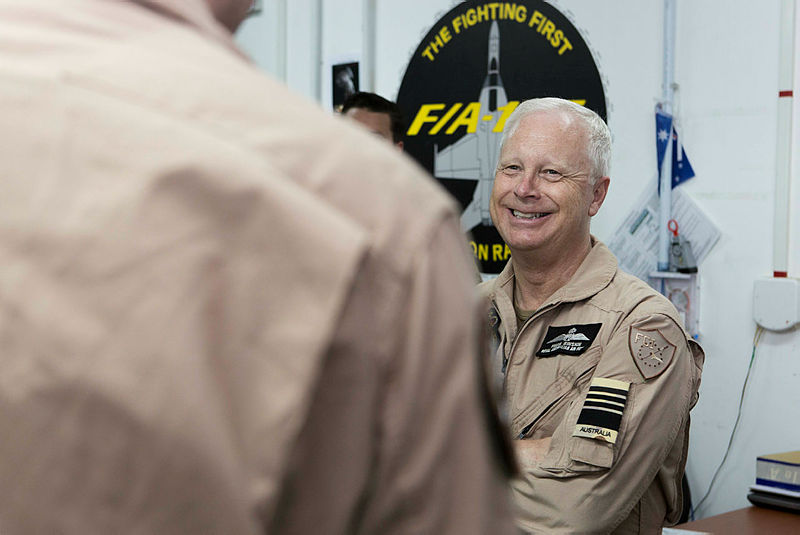
Welcome to The Strategist Six
, which provides a glimpse into the thinking of prominent academics, government officials, military officers, reporters and interesting individuals from around the world.
1. The ADF has been on operations overseas almost continuously since East Timor in 1999. Have the lessons learned been put to good effect?
We’ve learned a lot and we are building those lessons into our planning and our training. The result is a very effective and modern force. Since East Timor and Afghanistan, and now operating in support of the Iraqi forces, each soldier needs to be considered as an individual weapons system with a weapon, integrated communications, electronic countermeasures and body armour.
The Air Force has grown into a very potent force. When we were asked to contribute to the campaign against Daesh in Iraq we were able to put a self-contained air task group there within two weeks and to be on operations within three.
For Navy, decisions are coming on the nine new frigates and the Offshore Patrol Vessels taking on lessons from border protection and maritime surveillance. The OPV will be a bigger, more capable vessel which can operate in all conditions. The Army is getting new armoured reconnaissance vehicles to enable its people to do their job and survive.
The ADF is trained for diverse tasks from aid to civilian communities in times of disaster and relief operations in the region to high end war fighting if required. It has the ability to fight and win because, let’s face it, that’s what it’s there to do. There are some big challenges coming, including some of the acquisition projects. But the biggest lesson we’ve learned is that it’s your people that matter.
2. Is the ADF a truly ‘joint’ force?
It’s evolving very well. Army, Navy and RAAF are totally interoperable with the connectivity to pass information around quickly to help the decision makers whether that’s a corporal on the ground or a company on patrol, through to the Commander of Joint Operations (CJOPS) making strategic decisions.
CJOPS can focus on those operations and let the service chiefs raise, train and sustain the force. The next step is to appoint a manager to provide the necessary capabilities which don’t naturally fit within a single service such as cyber, intelligence, health, education and training. In July the ADF will appoint a two star officer as chief of joint capabilities who will bring all of these enabling systems together. That’s the bit we haven’t done as well as we should and what we are going to focus on for the near future.
3. What changes have most significantly improved the ADF’s effectiveness?
The acquisition of the RAAF’s giant C-17 transport aircraft and the introduction of Navy’s two LHDs, HMAS Canberra and HMAS Adelaide. The C-17 has fundamentally changed the way we can operate and very significantly extended the options the CDF can give the government. We can be in place, across the world in 48 or 72 hours. An example was going into Ukraine to work with the Netherlands repatriating the remains of those killed on the downed Malaysia Airlines Flight MH17. When the cyclone hit Fiji, the RAAF was able to fly in helicopters aboard C-17 to help immediately while HMAS Canberra loaded up with stores and heavy equipment.
4. What will the Joint Strike Fighter bring to the broader ADF?
A lot, as it integrates with the rest of the force. The JSF is much more than an aeroplane. It’s not just the missiles and air to surface weapons it carries but the information it gathers and its ability to disseminate it to whoever needs it, tactically right there and then, or to send it for analysis for future fights. The F 35 will be taking information from the battlefield control system like the Wedgetail, Tritons Predators, Reapers—anything that’s out there with fifth generation capability will be able to pass that information backwards and forwards. The soldier on the ground won’t know that’s what’s providing him or her with the picture of what’s going on around them. The RAAF’s Operation Jericho is about having the rest of the ADF think about how you use fifth generation equipment to best effect.
5. The ADF is in the midst of a massive re-equipment program but some of the 12 new submarines, for instance, will not be operational for decades. The Defence White Paper warned of uncertainty in the region. Will Defence get this equipment in time to deal with any threat and, if not, will that mean capability gaps?
I don’t think about it that way. We are always an evolving force so what we know is rolled into our current systems. The Collins submarine has evolved with upgrades of its capabilities including weapons and sensors. The RAAF’s Classic Hornet now is nothing like the Classic Hornet I learned to fly in 1984. It’s a far more capable aircraft through upgrades to weapons, systems and how we train. The Collins are very capable submarines and they will be going until the new submarines are ready to replace them. The Collins and the RAAF’s new P8 Poseidon maritime patrol aircraft and unmanned Tritons and frigates will all have an anti-submarine capability.
6. Since the Martin Place siege there have been calls from some quarters for a greater ADF role in dealing with domestic terrorist attacks. Should the ADF do more in this area?
The ADF’s primary role in counterterrorism is offshore. Our main aim is to stop terrorists getting here. We’re in the Middle East to stop the flow of foreign fighters back to the region and to our country. Should something happen onshore that is beyond the skills and capabilities of the state or Federal Police, we could be called in. But predominantly the first responder will be the state police. For major events such as international summits or the Olympics then the ADF will work closely with the police.
 Print This Post
Print This Post